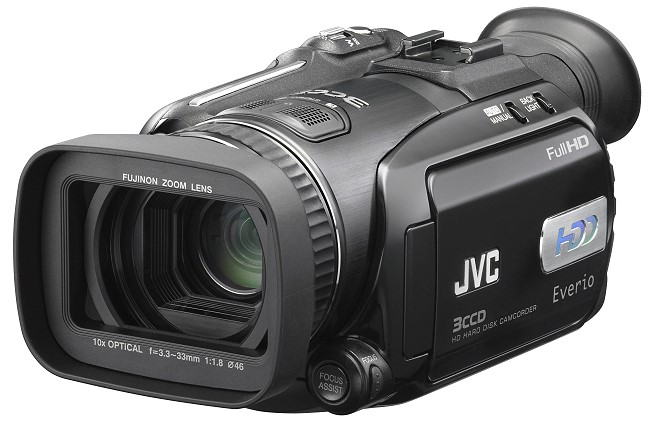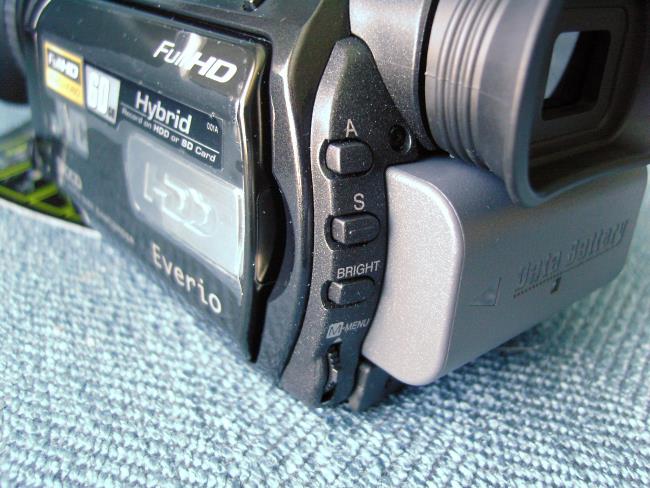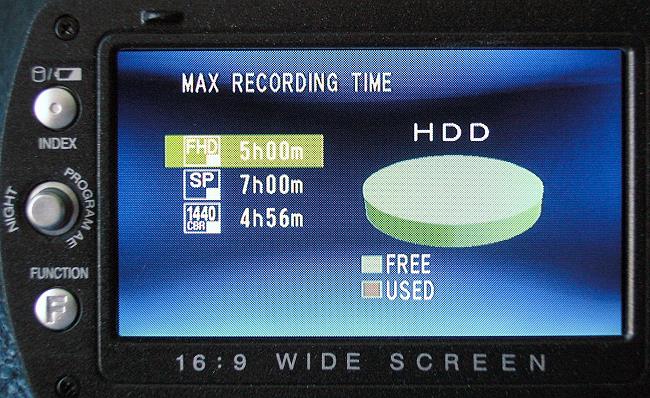Introduction
Video aficionados have all been waiting for consumer HD video cameras to
finally have full 1080i recording.
They are here . . . well, sort of.
The new JVC GZ-HD7 is 1080 alright, but it has
to interpolate to get the complete 1920x1080 dimensions. That is because, even though there
are three CCD sensors, each one is 530 k-pixels (slightly offset from one
another), which totals 1,590,000
pixels. For full native 1920x1080 resolution, there would have to be a
minimum of 2,073,600 pixels, so although the HD7 touts 1920x1080 recording,
it does it by interpolation. It has a 1440x1080 mode, and there are enough
native pixels for that resolution.
The Design
The GZ-HD7 and GZ-HD3 are two of JVC's newest
HD cameras, and they record the video data onto hard drives. This designates
them as HDD (Hard Disc Drive) cameras.
Both of these cameras have three 530 k-pixel
CCD sensors, but the HD3's highest resolution recording mode is 1440x1080.
The HD7's 1920x1080 mode records at 26.6
Mb/sec, which is very high. In fact, this is as high as Blu-ray and HD DVD
movie discs (true 1920x1080), and higher than 1920x1080 satellite HD
broadcasts. Therefore, the limitation here is really just the less-than-2,073,600
pixels in the sensors rather than the recording rate capability, and I
suspect we will see native 1920x1080 recording in the next JVC HDD HD video
cameras.
The GZ-HD7 is very light, compact, and
ergonomically shaped.

In the view shown below, you can see the
hand strap on the right side. You slip your hand through the strap from the
bottom, and fingers over the top.
The large LCD viewing screen folds out on the
left, and can be tilted for viewing when you have the camera at waist
height, and also turned so that you can view it from the front.

The left side has some of the control buttons,
including the one that activates the setup menu on the viewing screen.

At the bottom left corner are Aperture
Priority, Shutter Priority, and Brightness adjustment buttons for use in
manual mode. The Menu lever adjusts the values when each of those three
buttons are activated.

On the right side of the camera are the On/Off
dial and the Record button. When your hand is in the strap, the thumb
naturally rests near that button.
The Fujinon lens has a cover that closes to
protect it when the camera is off.
The slider for telephoto/wide angle is on the
top.

The menu structure is shown below.
The first one is simply what you see on the
screen while you are using the camera. It tells you that you are in Video
mode (rather than snapshot mode), Automatic rather than Manual, Full HD, 5
hours of recording time available, Paused rather than recording, and the
battery is fully charged.

Housekeeping activities include formatting the
drive and deleting files. While tape has a continuous set of video
information, the HDD cameras store each scene (pressing the Record button,
recording a scene, then pressing the Pause button) as a file in its own
folder. The extension is *.tod. So, when you are ready to move everything to
your computer for editing, all of the folders get uploaded to your PC. Each
one has to be opened individually. The extension appears to be rather new,
as I had difficulty using any of my digital video editors to work with them.
Eventually, I got Sony Vegas to open them. I anticipate that software
updates will soon be available so that the programs will recognize them.

This menu lets you select the output you want
to work with.

Here, you can adjust the recording volume and
add a Wind Cut filter. OIS reduces the effects of hand movement during
recording. There is also a Drop Detection feature that parks the hard drive
instantly if you drop the camera.

We are even starting to see some professional
video adjustments on consumer cameras, such as "Zebra" which is for
calibrating the brightest portions of the scene so that you don't "blow out"
the whites.

This screen shows you the recording time left
in the recording mode you have selected. Note that this camera does not
record in NTSC SD (640x480), but you can of course, convert an HD video to SD in
your video editor.

All in all, the HD7 has the most complete
feature-set I have yet seen on a video camera. It also includes a small
remote control for getting yourself into the picture, or maybe starting a
recording if you are trying to video birds with the camera nearby and you at
a safe distance away.
Go to Part II.